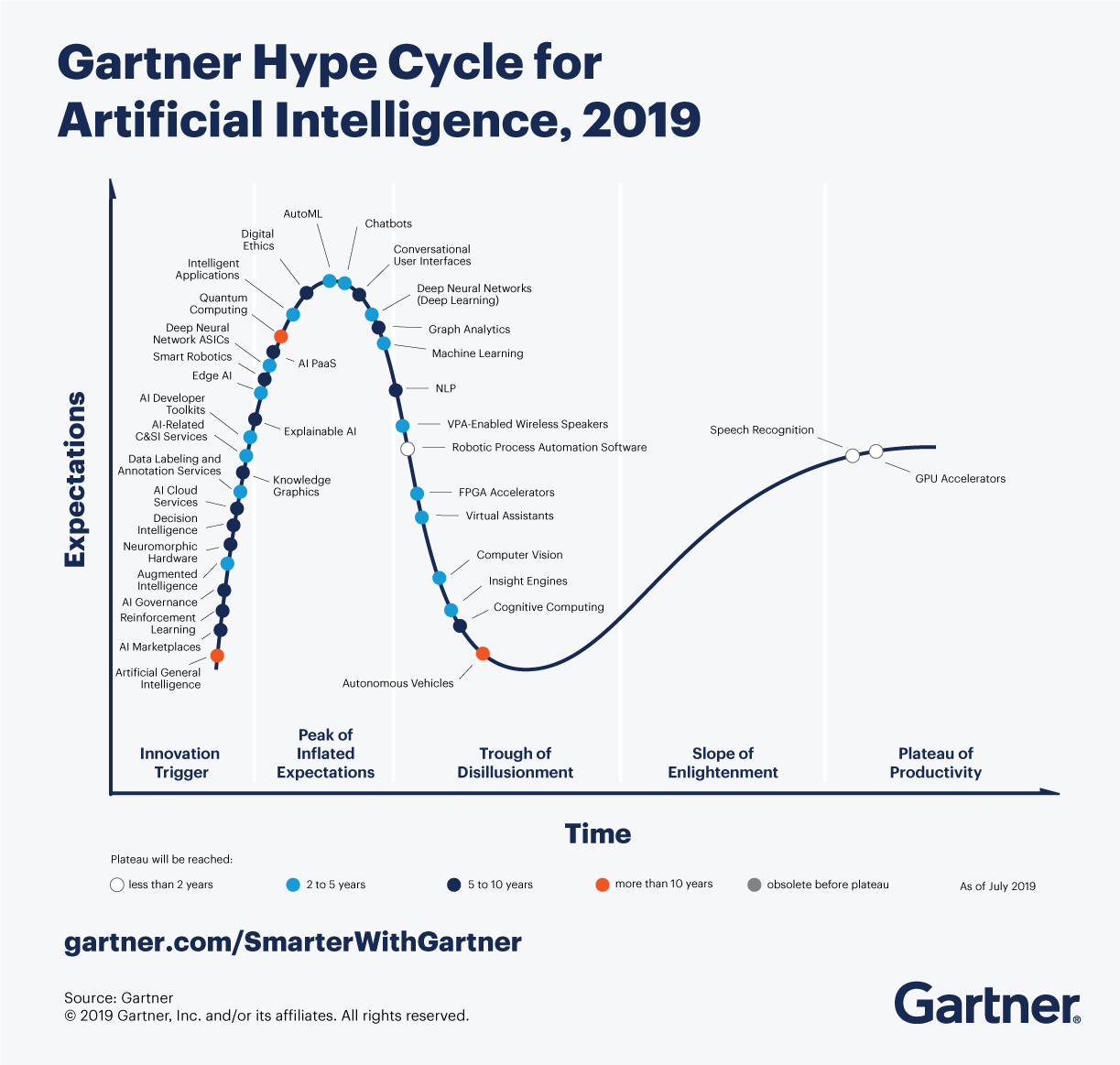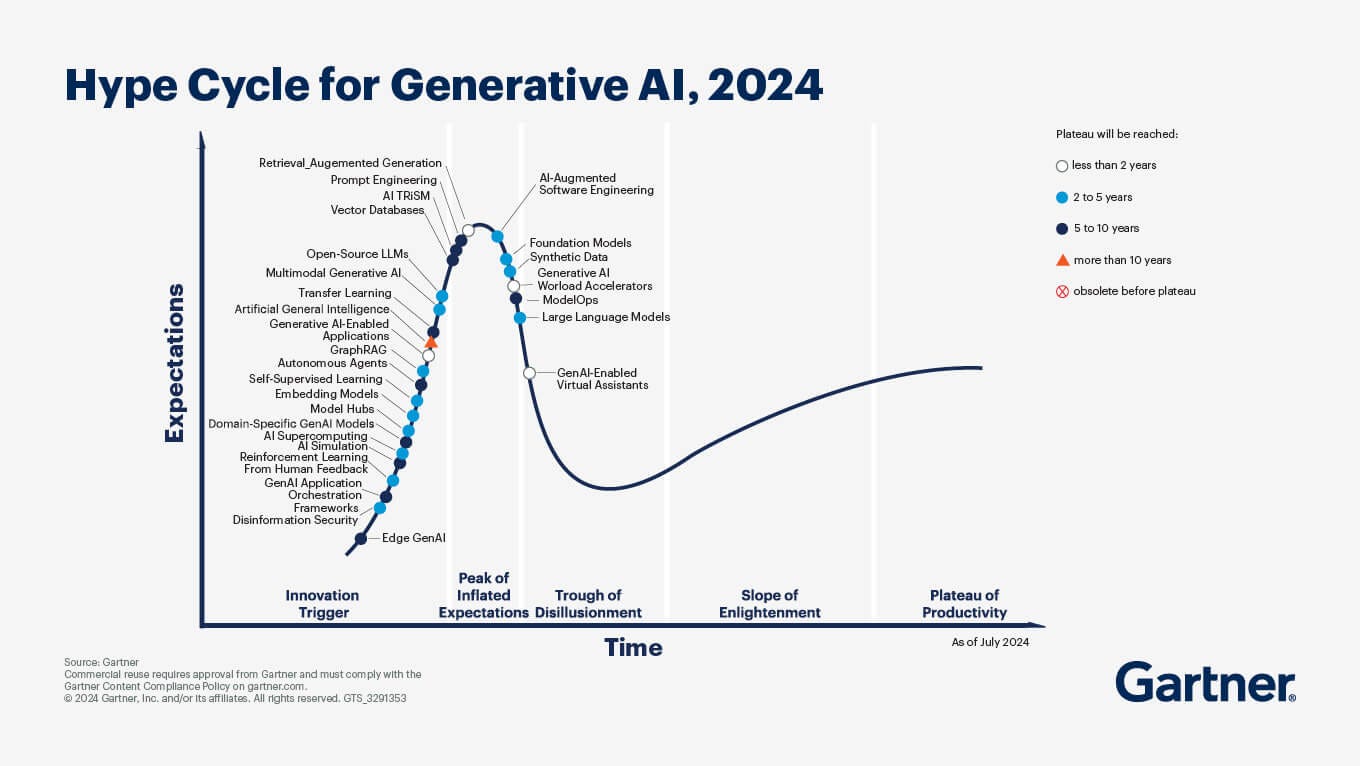How to survive the AI hype cycle
There are calmer ways to generate signal from the noise
Hola. 👋
I write to you with the Real Madrid stadium on the skyline. Appropriately, this edition is all about winning with AI by keeping it real.
Is AI making gold for those going all in?
Are you missing out if you're tinkering on the sidelines?
Let's unpick AI hype: what it is, what it's giving, and what it’s taking for folks leading a business.
The noise to signal is deafening
AI evangelists declare in hushed breaths, and incredibly long LinkedIn posts punctuated with rocket emojis 🚀: Anthropic can now reason like a human. GPT-5 will usher in a brave new world of super-intelligence. Gemini has cracked the code of consciousness. Get on the A-train now or end up stuck forever at the station.
The Godfather of AI, Geoffrey Hinton, quits Google. As he heads out to the golf course, he casually shouts, “We’ll all lose our jobs, and you need to retrain as a plumber.” In the palm tree above, a stochastic parrot squawks “become a plumber” on loop, which it’s learnt to do from its natural parrot programming. It’s the only one with a bird's-eye view of this game of fools.
There are many forms of AI hype – utopian and dystopian. And it’s frankly exhausting.
Let's follow the money
Ed Zitron, the brilliantly ranty AI cynic, breaks down big AI hype: a staggering $560 billion in CapEx in the last year from the 'Magnificent Seven' top tech firms led to a measly $35 billion revenue, and ZERO profit. Microsoft fared best with $13 billion in AI-related revenues, but $10 billion came from OpenAI renting its Azure cloud.
The economics don't compute. As he says in his podcast:
"This is egregiously f**king stupid."
My calculations on Microsoft's recent bluster: AI grew profits by $500M. But that's a trivial 0.2% of its $245 billion turnover. And they've justified the recent 9,000 redundancies based on AI efficiencies. They’re gambling hard the investment will pay off.
Meanwhile, McKinsey reports that only 1% believe they've reached AI maturity with full integration into workflows. The average investment was $1.9 million, yet less than 30% of CEOs are happy with their returns.
While everyone's talking ‘bout an AI revolution, many businesses are struggling with basic implementation. Only 1 in 4 organisations surveyed by BCG had the capabilities to move beyond proof of concept. And these consultancies are talking to multinationals and larger enterprises with $$$$ to invest.
Back in the real world, most businesses can't get chatbots to reliably answer customer queries. "AI-first" darlings like Klarna now switch out bots with human agents, armed with the latest automation tools.
Who’s striking gold? Follow the money upwards to see who's winning from AI hype.
The consulting gold rush
Management consultancies are mining gold in them hills. BCG reckon AI engagements will account for 40% of its work by 2026, double 2024’s target. Accenture is committing $3 billion to double its AI workforce to 80,000 specialists.
Consultancies are coining it in from strategy workshops, transformation roadmaps and implementation support. But most consulting gigs deliver PowerPoints rather than business results. The consulting model thrives on complexity and repeat engagements. Simple and practical projects, particularly using off-the-shelf software, don't generate enough billable hours.
Trainers and evangelists
Now that AI literacy benefits are becoming understood, trainers are finally getting booked. There are some brilliant independent and boutique agencies. Yet the market is flooded with self-declared AI experts who are just a few pages further along in the book.
Many evangelise about the “transformational power” of AI. Some consult on GenAI based on general skills like how to prompt, without understanding how AI tools and outputs interact with proprietary technologies or customer data. Indies and smaller companies with less complex data and systems can gain a lot from this type of training. But bigger and legacy organisations, less so.
Going hard in on hardware
Nvidia's $4 trillion valuation and meteoric growth are driven by AI demand; its chips are the most sought-after for AI development. Cloud providers are seeing huge increases in GPU rental costs as companies pay premium prices for computing power. If you bought shares before the boom, you’re winning.
Rapid chatbot adoption
OpenAI reached over 100 million weekly users by late 2023, one of the fastest-growing software services in history. ChatGPT now serves 2.5 billion prompts per day. But it’s consumers who lead AI adoption, particularly Millennials, who integrate it into family life. Yet only 3% pay for AI licences. That's like everyone in the building using one apartment's Wi-Fi. Using AI for planning family Easter egg hunts and creating scenarios for Dungeons & Dragons is truly magnificent. But it's not the same as getting real results for your business.
Media dystopia
Extreme headlines about artificial general intelligence (AGI), and robots and AI wiping out entire industries, get eyeballs. Goldman Sachs's loosey-goosey 2023 claim that "AI Will Replace 300 Million Jobs" lit up social media algorithms. This clickbait headline compels Wall Street and the businesses beneath to take action. More so than the more accurate story, which is more like "AI Might Automate Some Tasks and Change Existing Jobs, But It's Slow and Complicated." That won’t help OpenAI raise another $6 billion for a new data centre.
The AI doomers are also making hay. "The AI Con" and "Blood in the Machine" are climbing bestseller book lists by stoking fears about mass unemployment and loss of human values. Fear triggers our 'fight or flight' neolithic brain, generating a stronger emotional response than joy.
There's even a model for it: are you a doomer, gloomer, bloomer or zoomer?
Side note: I am so here for this BuzzFeed-style AI adoption personality quiz, created by Sarah Ennett, based on my previous edition. My type: Bloomer. A pragmatic optimist. If you sit in the middle as a Bloomer or Gloomer, you're avoiding the worst excesses of 'Ostrich with head in sand' Doomers or 'everything AI all at once' of exhausting Zoomers.
Where are we in the AI hype cycle now?
We've been here before with AI hype in the 1970s, expert systems in the 1980s, neural networks in the 1990s and deep learning in the noughties. Each wave promised to accelerate past experiments. Each dazzling expectation eventually withered into an "AI winter".
Gartner is the emperor of analysing tech hype since its first hype cycle in 1995. You may recognise its jaunty diagram from the logo of this newsletter. Some think tech hype cycles are just posturing; predicting tech futures is more crystal ball than crystal clear. Tom Goodwin notes that transformation technologies like Wi-Fi, GPS and the smartphone never made it into any of Gartner’s predictions.
AI appeared in the hype cycle for emerging technologies in 2012 and was gifted a dedicated hype cycle in 2019. How did they fare in accurately predicting AI hype?
2019’s predictions are some way off: Artificial General Intelligence (AGI) is still a twinkle in Sam Altman's enlarged eyes, quantum computing is still lagging and GenAI wasn't even under consideration. In 2023, it predicted we were at peak GenAI hype, when in hindsight we know it was the start.
Five years later, the mapping is unrecognisable. In 2024, AGI is rising as GenAI and large language models (LLMs) dip down from the “Peak of Inflated Expectations.”
Gartner published new predictions in July 2025, but you need to be a subscriber to get the details. The summary teases: 2024 was all about GenAI hype; we're now facing the “Trough of Disillusionment”. Mature organisations are finding it hard to get talent (presumably at a lesser scale than Meta's eye-peeling $1 billion talent offer, which was STILL rejected). The “Plateau of Productivity” is in reach for AI engineering and model operationalisation (ModelOps) – that's integrating AI into business operations.
Meanwhile, AI-ready data and agents are at the “Peak of Inflated Expectations”. Most AI systems, particularly GenAI, won't work well without clean, well-structured operational data. "Garbage in, garbage out", as researchers politely say. Or, as I prefer, "you can't polish a turd (but you can cover it with sprinkles)."🎉
Gartner claim more than half of organisations' data isn't AI-ready, so let's assume that for SMBs and legacy industries, it’s even worse. Data security and governance pose huge risks by adding AI agents to automate business processes. Add dirty data to the mix, and the consumer user stories, like ordering a pizza, may be a more realistic goal for now than complex corporate system integration.
AI is coming for software engineering, shifting from coding assistants to more fully automated development and testing. Not all engineers will be lying back (or laid off) with a piña colada, as complex multi-agent workflows could increase security vulnerabilities. If each agent hallucinates or produces a small error, this could compound in a messy, real-life version of Chinese whispers.
I have a lot of respect for Gartner's analysis. It's thorough and considered. It usually avoids hyperbole and generalisations, in contrast with other big consultancies. But whichever narrative you tune in to, this wave of the hype cycle is in a different territory:
RNLI: Ridiculous and Nauseating Levels of Investment.
All the cash thrown at data centres and consultancy means AI won't be going away. There'll be a relentless focus on getting us to the "Plateau of Productivity". Many will claim we're there without the data to back it up. Treat these claims with caution: every organisation is in a different state of technology and data maturity. An investment in AI now won't guarantee growth down the line. You need to plough your own path.
FOMO is not a strategy
AI hype isn't just misleading. It could harm your ability to make sound investments. Artificial intelligence hype's prime outcome is artificial urgency. And it can derail business planning.
FOMO is not an AI strategy.
(Unashamedly stolen from Rachel Coldicutt @ Careful Industries).
It encourages reactive rather than strategic thinking.
It prioritises being seen to do something over doing the right thing for your organisation.
For boards lacking a technology strategy, each magical new automation solution and AI model launch spins on the sixpence, derailing months of planning.
Those selling the hype aren't the ones dealing with the messy reality of integrating AI with complex legacy systems. And even more complex legacy thinking.
We mustn’t blindly accept that everything is now all about AI, and all we need to do is switch the tools on and off. And we absolutely must not absolve decision-making to AI agents that don't understand the nuances of our unique business needs and interests.
How I learnt to stop worrying and ignore AI hype
Counter to all this: AI hype, both utopian and dystopian, can be good. It highlights potential opportunities and risks and encourages us to think and decide where we stand.
I’ve seen tech hype before. I started my career in the noughties internet. Websites were quaint digital gardens built in Geocities, lovingly crafted in the individual eye of their webmaster (or web mistress). It felt like the Wild West, but also a brave new world of possibilities. Fortunately, websites soon became more standardised and useful for doing things with.
Web3 had some false starts. Remember Zuckerberg's obsession with the Metaverse? We aren't all dancing in disembodied virtual galaxies just yet. There was hype, but the metaverse promised imagination and new possibilities.
Perhaps what turns me off AI hype is the relentless focus on lightning speed, efficiency and money, money, money. This isn't the most exciting or interesting thing about AI. I'd rather be in a world where AI helps creatives and product owners mock up new ideas quickly, build personal maths lessons from the perspective of the pet dog, or bring to life kids’ doodles in 3D.
Let's stay focused and upright long enough to see past the mountains of madness to reach AI's potential on the other side.
How to keep calm and carry on past the AI hype
Be rigorous
Ask difficult questions at the start of the project:
What specific business problem does this solve?
Example: Our customer service team spends 3 hours daily answering similar query emails.
How will we measure if it's working?
Example: Measure time saved and assess quality by comparing ratings from customer feedback surveys.
What will we do if this doesn't work?
Example: Have a low-risk test and honest review process before a wider rollout. There will be trade-offs in speed, accuracy and quality. Some projects may improve all three, some may unreasonably degrade standards and require a rethink.
Plan for AI governance
Establish an AI Council or other governance structure to review pilot projects and assess feedback and potential criticism from internal users and customers. This group should include technology leaders (implementing solutions) and advanced users in different business units. Include sceptics, not just enthusiasts. Your Council is a firewall between your business strategy and the latest “mind-blowing” AI announcement. Let others beta-testers bask in the glory of being first: then steal their lessons. The 'cool wave' after this is the one to catch.
Budget for reality
Forget the optimistic timelines and radical claims sold to you by vendors. Plan for a slower, more complex adoption that takes time to get it right and bring everyone on board. Be suspicious of "AI-powered" claims (often ChatGPT bolt-ons to existing software). AI tools aren't magic beans that will immediately sprout a giant beanstalk. If it sounds too good to be true, it probably is. Allocate most of your budget to system integration, data cleanup and training. Software is the simple part.
Watch and WAIT
It's OK to WAIT. That means you're Working on AI Transformation. Observe, plan, test.
Subscribe to trusted sources. Around five newsletters specific to your industry, and 10 LinkedIn experts is enough. Subscribe to this newsletter and Ethan Mollick's One Useful Thing as your generalist for a measured view of successful adoption.
Start small, think big
Start with problems you really want to solve. Identify one repetitive process that's painful for your team. Scale after proving it actually works. Innovation tends to happen at the edge between formal systems and tinkering. You may even need to work out how you want to play with AI.
Don’t believe the hype
Ed Zitron believes AI hype supports his 2023 Rot Economy thesis:
"The growth-at-all-costs mindset that has driven every tech company to focus on increasing quarterly revenue numbers, even if the products suck, or are deeply unprofitable, or, in the case of generative AI, both."
If you feel you’re getting sucked in, squeeze a drop of Zitron. Or Public Enemy.
Don't believe the hype.
Tech hype emits its own smokescreen (along with the real smoke of harmful emissions). It benefits consultants and tech vendors.
Hype doesn't grow your business.
Tech doesn't grow your business.
But the right combination of people, processes and technology can.
How does AI hype affect you? Have you experienced vendor promises that didn't deliver? This post is free to share. Add your thoughts in the comments.





I loved this post Susi - especially where you compared the amount of investment the big players have put into AI, the scary job loss pronouncements, and the actual profit generated!! I actually quoted you on this in a couple of conversations that I had on Friday. Those conversations were focused on a different aspect of this paradigm. All the investment and all the focus on engineering process - how much power, how fast or some other mesaure of 'greatness' - but all in aid of what? Where's the real progress that will make significant improvements to people's lives? As one of the people I was speaking to said, why not focus on the world's 'big challenges' like clean drinking water, decarbonisation, food security and so on, and drive progress towards those goals.